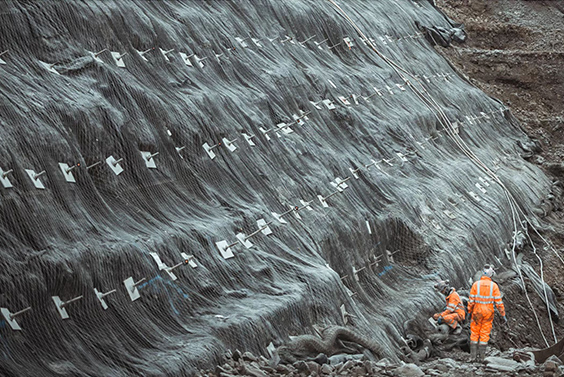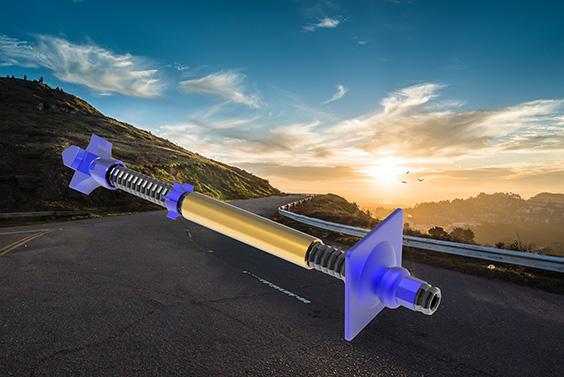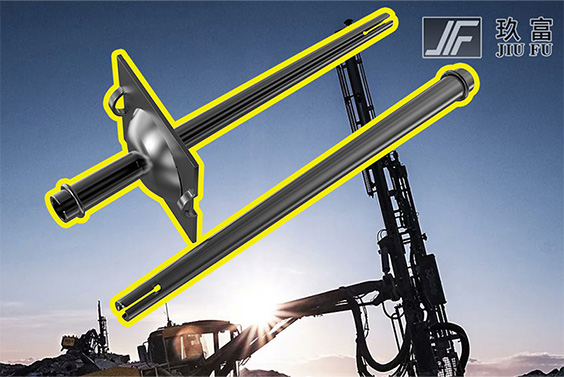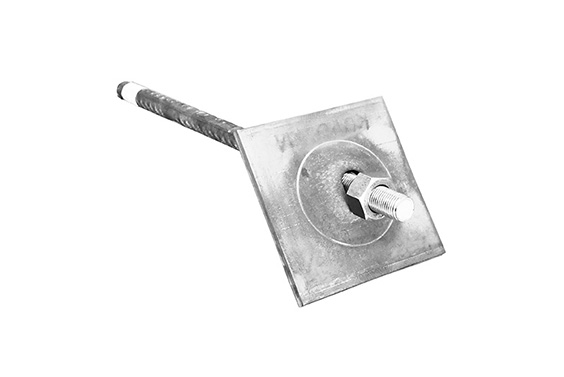

This page will bring you the latest news from JiuFu!

Foundation support is a link in construction, which ensures the stability and efficiency of the building structure. Support projects require related support products, including rock anchors. In order to meet the construction requirements of different support projects, anchors are also divided into many types. Jiufu's anchors are mainly divided into self-drilling hollow anchors, pipe seam anchors, threaded steel anchors, etc. Each type of rock bolt has its own unique characteristics, advantages and disadvantages, making it suitable for different slope conditions and support requirements. This article mainly introduces the definition and construction method of each anchor to help you better understand rock bolts.
Hollow Self-Drilling Anchor Rod

Definition:
The interior of the self-drilling hollow anchor rod is hollow and has no entity. During the drilling process, the air and water inside can move freely and wash away the particles. There is a continuous thread on the outside, which can be cut off at any position. It is also equipped with a drill bit for drilling holes. Due to its own characteristics, the application range of self-drilling hollow anchor rods is very wide. They can be used for tunnel stabilization, embankments and slopes, avalanche safety protection, as well as pre-support engineering, radial support engineering, edge skin stability, foundation support engineering, tunnel support engineering and other rock support work. Since the anchor rod itself is an advanced system, the installation steps are simple and the operation is easy. It can operate under broken foundation conditions such as soft rock, loose soil layer, weathered layer, gravel layer, etc., and can complete drilling, grouting, anchoring and other operations at the same time, greatly improving work efficiency. Anchor rods are widely used and widely used in a wide range of fields, and are favored by users all over the world.
Construction method:
Jiufu self-drilling anchor rods are usually installed by rotary impact drilling. This technology has a high installation rate and good directional stability, which is conducive to the consolidation of slurry in the hole.
1. Connect the alloy drill bit and anchor rod at one end, connect the drill sleeve and joint at the other end, and then connect the drill rig or handheld drill. Then start drilling and add cooling water while drilling. (If you need to lengthen the anchor rod, you can connect the coupling and then drill the hole)
2. Remove the drill bit, insert the grouting plug into the rod, insert it into the hole and prepare for grouting.
3. Connect the grouting joint and the anchor rod end, and connect the other end of the grouting machine.
4. Start grouting. After the grouting is full and reaches the design value, turn off the power. The grouting pressure is determined according to the design parameters and the performance of the grouting machine.
5. Install the base plate and nuts, and tighten the nuts.
Friction Anchor

Definition:
Jiufu Friction Anchor Bolt is a threaded anchor system specially designed for underground engineering support. Suitable for use in tunnels and mines, especially for use in machines, walls, or rocks, and also for metal mining operations. Its operating principle is to improve the stability and safety of the rock by tightening it when lateral ground movement occurs, preventing unstable situations such as rock collapse or fragmentation and soil landslides, and ensuring the safety and stability of the engineering project.
Construction Method:
1. Drill holes according to specifications: Use a rock drill to drill holes in the ceiling or walls. The diameter of the hole will be slightly smaller than the diameter of the bolt.
2. Pay attention to keeping clean: Compressed air is recommended to clean the holes and remove dust and loose particles.
3. Insert the bolts: Insert the split friction bolt into the hole that exactly lines up with it, making sure the tray is resting on the surface of the ceiling or wall.
4. Installation: Place the installation tool on the bolt head and tap with a hammer until the bolt is fully installed. Tool and hammer strikes must be perfectly aligned with the bolt axis to avoid distortion. The bolt head deforms slightly to make contact with the ceiling or wall surface, creating friction that helps maintain stability.
5. Verification check: Verify bolt installation to ensure it is placed correctly and has the proper tension.
Threaded Steel Anchor

Definition:
Rebar is the common name for hot-rolled ribbed steel bars. Usually has 2 longitudinal ribs and transverse ribs evenly distributed along the length. Due to the role of ribs, ribbed steel bars have a greater bonding capacity with concrete and therefore can better withstand external forces. Ribbed steel bars are widely used in various building structures, especially large, heavy, and high-rise building structures.
Construction method:
1. Cutting:
The rebar should first be cut to the appropriate size based on the required length. When cutting rebar, you must use appropriate tools and equipment and keep the blade sharp to ensure smooth cuts and dimensional accuracy.
2. Drilling:
When rebar needs to be fixed to a concrete structure, it is necessary to drill holes and install the rebar. When drilling, you should choose an appropriate drill bit and keep the drill bit clean and sharp to ensure the accuracy and quality of drilling.
3. Thread Processing:
Threading is required when connecting rebar to other rebar. When processing threads, appropriate processing equipment should be selected and kept clean and sharp to ensure that the threads are accurate and locked firmly.
4. Connect:
When connecting rebar, attention should be paid to the tightness of the connection to ensure a firm and stable connection. At the same time, attention should also be paid to the quality and properties of the connection materials and the appropriate connection method should be selected.
5. Concrete Pouring:
When the rebar is fixed on the concrete structure, the concrete should be poured in time, and attention should be paid to the pouring method and pouring quality of the concrete during pouring to ensure the firmness and stability of the concrete.
About Jiufu
Jiufu specializes in the production of mining support equipment products. Our advantageous products include self-drilling, hollow anchor rods, pipe seam anchor rods, welded mesh, diamond mesh, U-shaped steel, etc. Jiufu is committed to providing the best quality products at the most competitive prices in the safest working environment.If you want to know more about our products, please click: www.jfrockbolt.com